Monthly crawl space checks prevent costly infestations by catching early warning signs before they escalate into major problems. You’ll spot moisture accumulation, pest droppings, gnaw marks, and structural damage that can cost $3,000 to $25,000 if left untreated. Regular inspections help you identify entry points, monitor humidity levels, and detect termite or rodent activity during peak seasons. This proactive approach saves thousands in repairs while protecting your home’s structural integrity and your family’s health through targeted prevention strategies.
The Hidden Dangers Lurking Beneath Your Home
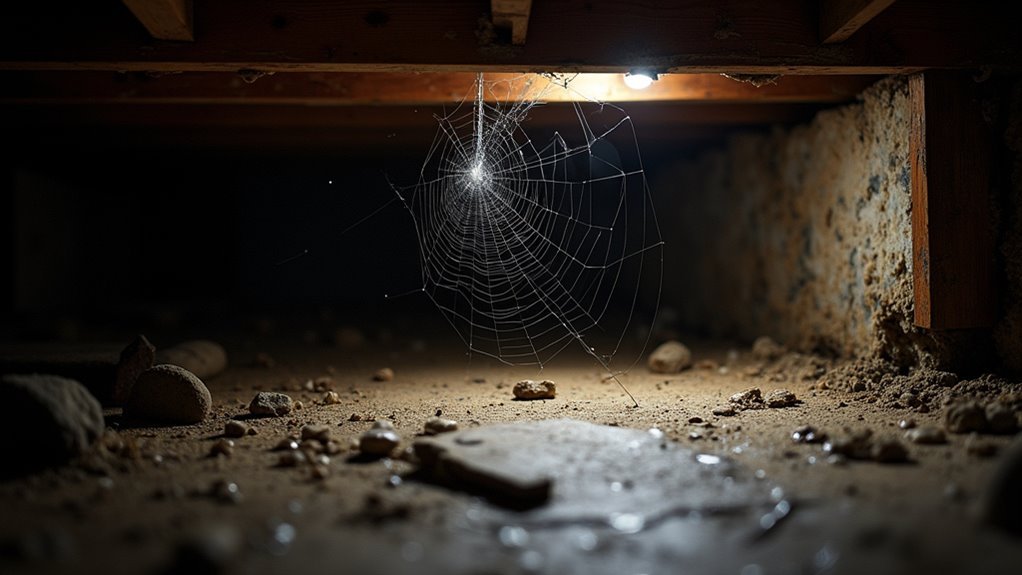
While your home’s crawl space remains out of sight and mind, it’s silently creating the perfect storm for costly problems.
You’re unknowingly providing termites and rodents with their ideal habitat—a damp, dark environment where they’ll thrive and multiply. Moisture accumulation transforms this neglected area into a breeding ground for destructive mold that’ll compromise your home’s structural integrity while triggering serious health issues for your family.
Without your knowledge, water intrusion creates pooling that goes undetected, causing severe structural issues over time.
Poor ventilation and inadequate insulation worsen humidity levels, making infestations more likely while driving up your energy costs.
You can’t address what you don’t see, which makes these hidden dangers particularly threatening to both your wallet and well-being.
Common Signs of Pest Activity in Crawl Spaces
Your nose often provides the first warning sign that unwanted guests have moved into your crawl space. Foul odors from decaying pests or accumulated droppings signal active pest infestations that demand immediate attention.
Trust your sense of smell—persistent foul odors from your crawl space indicate serious pest problems requiring swift action.
During your crawl space inspection, look for telltale droppings near food sources and nesting areas, which clearly indicate rodent or insect activity.
Gnaw marks on insulation, wood, or electrical wiring reveal how pests create nests and access resources. You’ll often find visible structural damage to ductwork and chewed electrical systems, compromising your home’s essential components.
Moisture damage can attract pests seeking water sources.
Listen for unusual nighttime sounds like scratching or scurrying, which confirm active infestations. These signs highlight why regular inspections prevent minor pest problems from becoming costly structural nightmares.
How Moisture Creates the Perfect Breeding Ground for Infestations
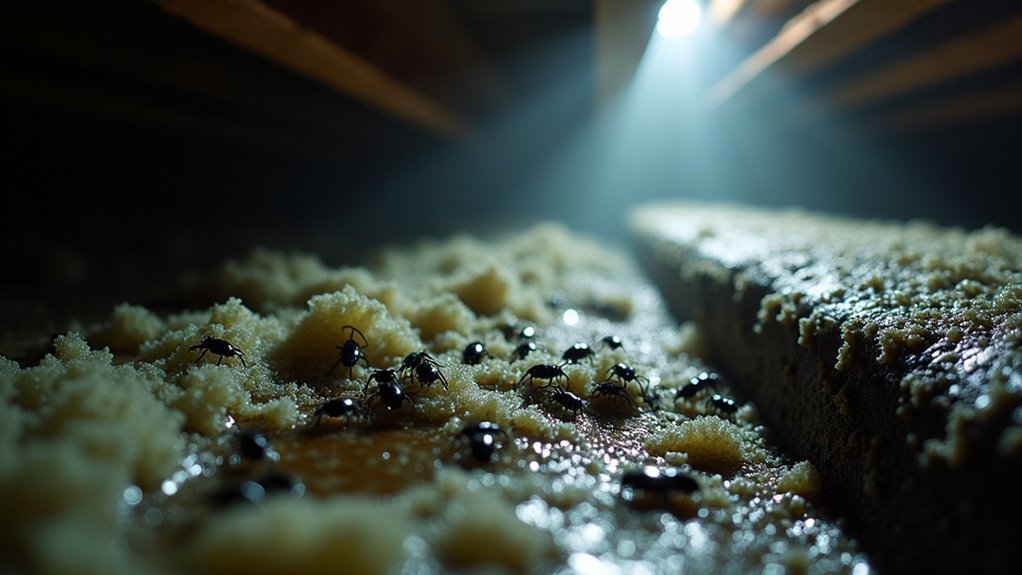
When moisture accumulates in your crawl space, it transforms this area into a pest paradise that attracts some of the most destructive home invaders.
Termites, rodents, and mold all thrive in damp conditions, making your home vulnerable to costly infestations. High humidity creates standing water where mosquitoes breed, while excess moisture triggers mold growth that damages structural elements and attracts even more pests.
You’re facing a dangerous cycle: moisture leads to mold, mold attracts pests, and pests cause further damage.
Even a single leaky pipe can elevate moisture levels dramatically, creating ideal breeding conditions. To prevent these infestations, you must conduct regular moisture checks in your crawl space, identifying early signs of dampness before they escalate into expensive problems.
Essential Monthly Inspection Checklist for Homeowners
You’ll need to perform three critical checks during your monthly crawl space inspections to catch problems before they become infestations.
Start with a thorough visual damage assessment, examining foundation walls, insulation, and structural elements for any signs of deterioration or compromise.
Then monitor moisture levels throughout the space and detect any pest activity that could indicate the beginning stages of an infestation.
Visual Damage Assessment
While many homeowners overlook their crawl spaces until problems become severe, conducting monthly visual damage assessments can save you thousands in repair costs and prevent serious infestations.
These visual inspections should focus on identifying crawl space issues like moisture accumulation and early signs of mold growth before they escalate.
During your assessment, examine foundation walls for cracks that could indicate structural problems.
Look for pest droppings, gnaw marks, or other signs of animal activity that suggest infestations.
Check your vapor barrier’s condition to guarantee it’s effectively preventing moisture buildup.
Inspect insulation for damage or missing sections that could increase energy costs.
Pay attention to any water stains, musty odors, or discoloration on surfaces, as these often signal developing problems requiring immediate attention.
Moisture Level Monitoring
Because moisture levels directly impact your crawl space’s health, you must monitor humidity readings monthly to prevent costly damage and infestations.
Install a hygrometer to track moisture levels consistently. When humidity exceeds 60%, you’re creating favorable conditions for mold growth and pest infestations, including termites and rodents that thrive in damp environments.
Check for condensation or pooling water during your monthly inspections. These signs often indicate plumbing leaks or drainage problems requiring immediate attention.
High moisture levels pose serious health risks by enabling mold development, which affects indoor air quality throughout your home.
Professional crawl space services can help establish proper moisture control systems.
Maintaining ideal humidity levels also enhances energy efficiency, reducing strain on your HVAC system and lowering utility bills while protecting your home’s structural integrity.
Pest Activity Detection
During your monthly crawl space inspections, focus on identifying telltale signs of pest activity before infestations take hold.
When you inspect your crawl space, look carefully for droppings, nests, or gnaw marks that indicate unwanted visitors have moved in. These early warning signs help you address problems before they become expensive remediation projects.
Pay special attention to these critical areas:
- Entry points – Check foundation cracks, gaps around pipes, and ventilation openings where pests typically gain access.
- Moisture zones – Examine damp areas where rodents and insects are most likely to establish colonies.
- Structural damage – Look for chewed wires, damaged insulation, or wood that shows signs of pest-related deterioration.
Regular detection prevents minor issues from escalating into major infestations.
Early Warning Signs That Save Thousands in Damage Costs
You’ll save thousands by recognizing specific warning signs during your monthly crawl space inspections.
Moisture accumulation, structural damage indicators, and pest activity evidence are the three critical red flags that signal expensive problems ahead.
Catching these early warning signs can prevent repair costs ranging from $500 for pest treatments to over $30,000 for major mold remediation.
Moisture Accumulation Warning Signs
When moisture begins accumulating in your crawl space, it doesn’t wait long to cause serious problems—mold can start growing within just 24 to 48 hours of exposure.
You’ll need to recognize these warning signs before they threaten your family’s health and your home’s structural integrity.
The most telling indicators include:
- Persistent dampness on surfaces – Touch walls, pipes, and beams regularly to detect unusual moisture levels.
- Musty odors – That distinct smell signals potential mold growth requiring immediate inspection.
- Standing water or pooling – This creates ideal conditions for pests and compromises your home’s foundation.
High humidity exceeding 60% attracts termites and rodents while promoting wood rot.
Monthly checks help you catch minor leaks before they become expensive repairs, potentially saving thousands in remediation costs.
Structural Damage Indicators
Since structural damage often begins with subtle signs that homeowners overlook, catching these early indicators during your monthly crawl space inspections can prevent repair bills that easily reach into the thousands.
Look for vertical foundation cracks that signal underlying structural issues requiring immediate attention.
Pooling water or damp spots indicate moisture issues that trigger mold growth and wood rot, compromising your floor’s integrity.
Check insulation for drooping or damage, which reveals excessive moisture or pest activity that’ll escalate into expensive problems.
Examine HVAC ducts and plumbing for rust, as this exposes potential moisture problems leading to systemic failures.
Finally, detect voids in foundation seams to prevent progressive settling that causes severe structural damage.
Crawl spaces demand vigilant monitoring.
Pest Activity Evidence
Beyond structural concerns, pest activity leaves telltale signs that reveal infestations before they cause catastrophic damage to your home’s foundation and framework.
During monthly crawlspace inspections, you’ll discover evidence that saves thousands in repair costs when caught early.
Watch for these critical warning signs:
- Physical Evidence – Droppings, gnaw marks, and nesting materials indicate active pest presence requiring immediate intervention.
- Environmental Conditions – Moisture accumulation creates ideal breeding grounds for termites and rodents, accelerating structural damage.
- Secondary Indicators – Mold growth and musty odors signal both moisture problems and potential pest activity.
You’ll also notice damaged insulation and compromised HVAC ductwork, which directly impacts energy efficiency.
Early detection prevents minor pest issues from escalating into major infestations that threaten your home’s integrity.
Seasonal Pest Patterns and Peak Activity Times
Understanding seasonal pest patterns helps you anticipate and prevent crawlspace infestations before they become costly problems.
Termites and ants surge during warmer months, with peak breeding in late spring and early summer when temperatures rise and food becomes abundant.
You’ll face increased rodent activity in fall as they seek shelter from cold, making your crawlspace an attractive target.
Spring brings additional challenges when heavy rain and snowmelt create structural vulnerabilities like cracks that pests exploit.
Excess moisture during humid periods attracts mosquitoes and promotes mold and mildew growth.
Crawl space encapsulation can address these seasonal vulnerabilities by controlling moisture and blocking pest entry points, while monthly checks during peak activity periods help you identify early warning signs before infestations establish.
Professional vs. DIY Monthly Monitoring Strategies
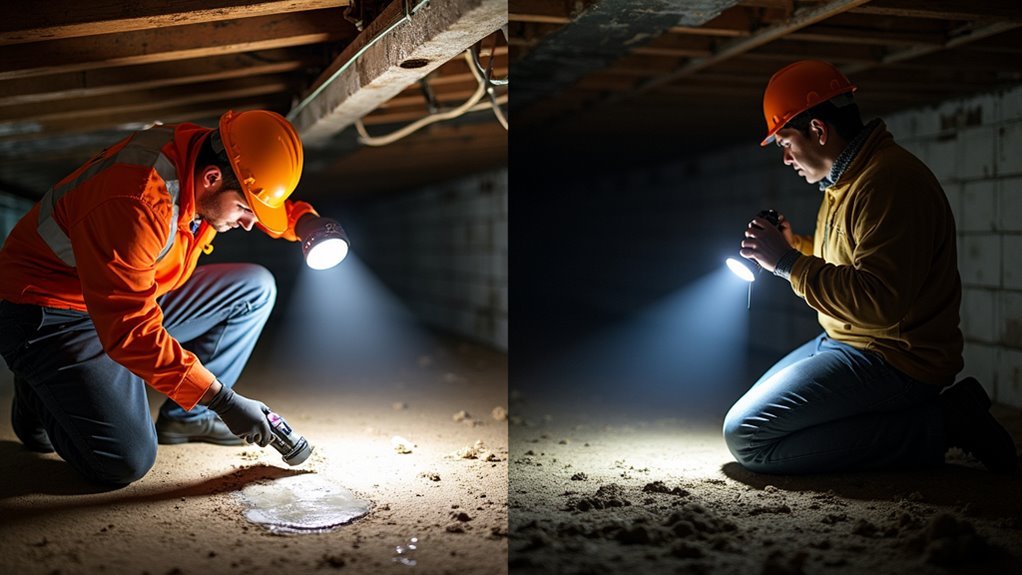
When deciding between professional and DIY monthly crawl space monitoring, you’ll need to weigh the thoroughness of expert inspections against the cost savings of self-checks.
Professional crawl space inspectors use specialized tools and protective gear to identify hidden structural damage and moisture problems you might miss. They’re trained to navigate dangerous environments while detecting issues early, protecting your air quality and health from mold exposure.
DIY monitoring offers cost-effectiveness but lacks extensive assessment capabilities. You may overlook critical warning signs that professionals catch immediately.
Key advantages of professional monitoring:
- Detailed reporting – Receive actionable recommendations with photographic evidence of problem areas
- Safety protocols – Trained inspectors minimize health risks from contaminants and tight spaces
- Early detection expertise – Specialized equipment identifies pest activity and moisture issues before costly damage occurs
Creating an Effective Prevention and Response Plan
Whether you choose professional monitoring or handle inspections yourself, you’ll need a structured prevention and response plan that goes beyond simple monthly checks.
Your plan should include sealing potential entry points where pests can access your crawl space, installing vapor barrier systems to control moisture levels, and establishing clear protocols for addressing problems you discover.
Document every inspection with photos and notes, tracking humidity changes and structural concerns over time.
Create a response timeline that prioritizes immediate threats like active pest activity or water intrusion.
Stock essential materials like caulk, mesh screens, and dehumidification equipment for quick repairs.
Establish relationships with contractors for major issues requiring professional intervention, ensuring you can act swiftly when problems escalate beyond DIY solutions.
Frequently Asked Questions
How Often Should You Check Your Crawl Space?
You should check your crawl space monthly to catch emerging issues early, especially in humid climates. Schedule annual professional inspections, but conduct immediate checks if you notice cracks, odors, or pest activity.
Do Houses With Crawl Spaces Have More Bugs?
Yes, you’ll likely encounter more bugs if your house has a crawl space. These dark, humid areas attract termites, ants, and spiders seeking shelter, creating ideal breeding conditions that increase pest activity markedly.
Does Crawl Space Encapsulation Prevent Pests?
Yes, crawl space encapsulation prevents pests by creating moisture barriers that eliminate damp conditions bugs love. You’ll seal entry points, control humidity, and reduce mold growth that attracts rodents and insects to your home.
Is a Crawl Space Encapsulation Worth the Money?
You’ll find crawl space encapsulation worth every penny. It prevents costly moisture damage, reduces energy bills, increases your home’s value, and eliminates expensive pest control treatments while improving air quality.
In Summary
You’ll save thousands by committing to monthly crawlspace inspections. Don’t wait until you’re dealing with structural damage or full-blown infestations. Set a calendar reminder, grab your flashlight, and make it routine. The fifteen minutes you’ll spend each month checking for moisture, pest signs, and structural issues beats paying for expensive exterminators and repairs later. Your wallet and your home’s foundation will thank you for staying proactive.

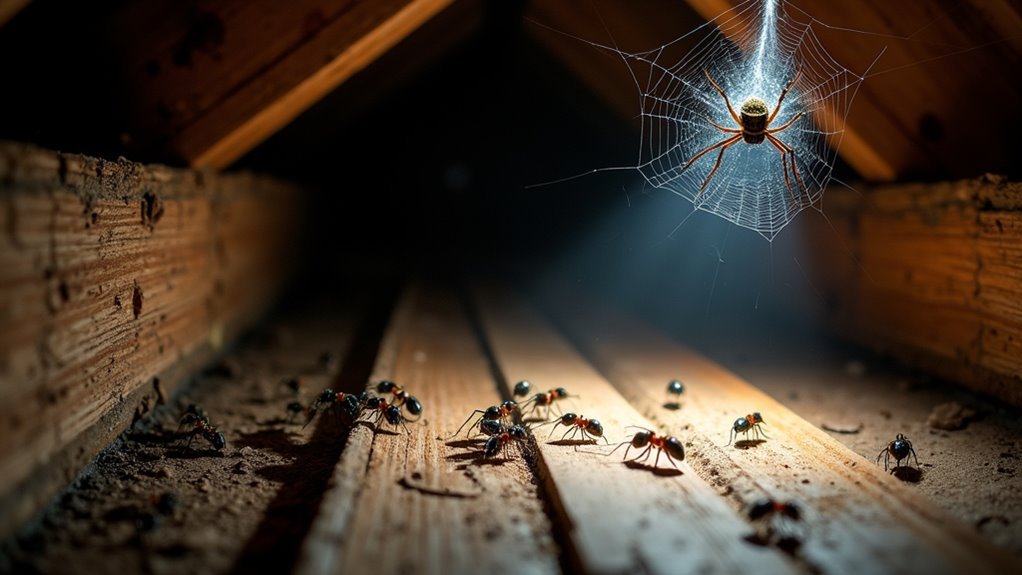

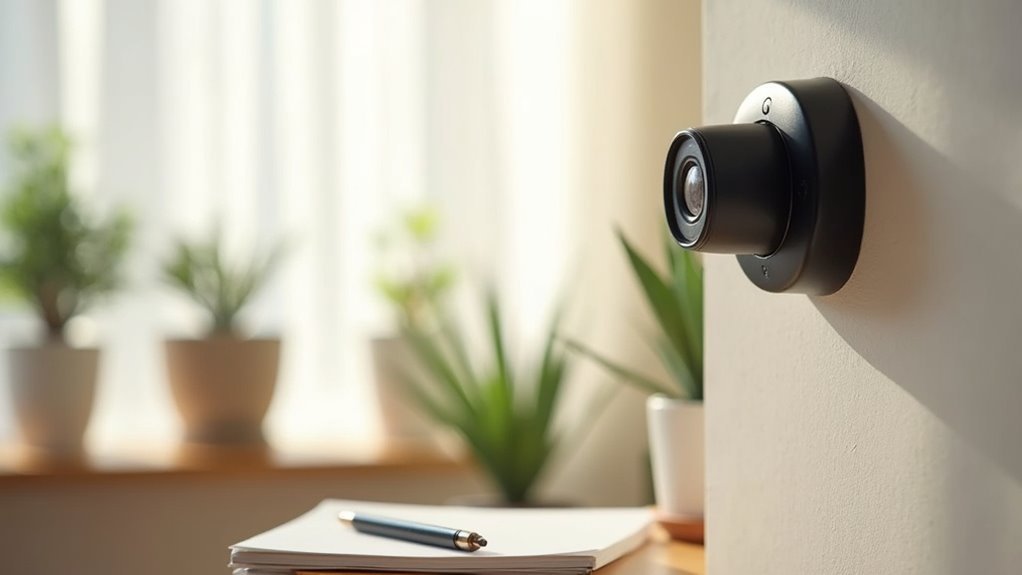

Leave a Reply